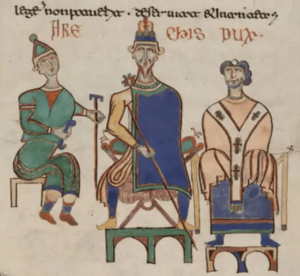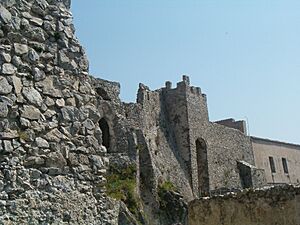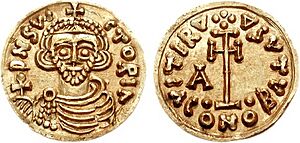Arechis II of Benevento facts for kids
Arechis II (born around 734 – died 787) was an important leader, known as a Duke, in Southern Italy. He ruled the Duchy of Benevento, a powerful area in Italy. Arechis wanted to make Benevento even stronger by taking control of lands still held by the Byzantine Empire. He also had to protect his duchy from Charlemagne, a very powerful king who had taken over northern Italy.
Contents
Who Was Arechis II?
Arechis was a descendant of the Lombards. The Lombards were a group of people who had moved into Italy in the late 500s. They set up their own kingdom in northern Italy, with its capital city at Pavia. They also had two independent areas in the south, called duchies: Spoleto and Benevento.
Arechis became the Duke of Benevento in 758, taking over from his father, Liutprand. He used the title "Duke" until 774. That year, Charlemagne conquered the Lombard kingdom in the north. After this, Arechis changed his title to "Prince of Benevento." This was probably his way of showing that he was still independent and not under Charlemagne's rule. He remained Prince until he died in 787.
Arechis's Family

Around 757, Arechis married Adelperga. She was the daughter of Desiderius, who was the Lombard king in northern Italy. Arechis and Desiderius had a friendly relationship, but Arechis kept Benevento mostly independent. This changed in 774 when Charlemagne defeated Desiderius and took over his kingdom. Arechis and Adelperga had five children together: three boys and two girls.
Supporting Arts and Culture
Arechis and Adelperga were big supporters of culture and learning for their time. Adelperga asked a famous Lombard writer named Paul the Deacon to write a book called Historia Romana. This book was about Roman history and was used as a textbook for a long time. Some historians also think they asked Paul to write his more famous book, Historia gentis Langobardorum, which was about the history of the Lombards.
Arechis also helped move important religious items, called saints' relics, to a new church he built in Benevento. This church was called Santa Sofia. The church is still standing today, though it has been repaired many times. It has rare paintings from the 700s inside.
Arechis also spent money on building projects in Salerno. He built a new palace and a castle there. Salerno became a very important port city during his rule. He also gave a lot of money to big monasteries in the south, like Montecassino and San Vincenzo al Volturno.
Important Political Actions
Arechis was the Duke when Charlemagne conquered the Lombard kingdom in northern Italy in 774. Even though Arechis refused to fully accept Charlemagne as his new king, Benevento was mostly left alone. In that same year, Arechis officially took the title "Prince of Benevento." He also created some new laws. Both of these actions were likely a way to show Charlemagne that he was independent. Before this, only Lombard kings made laws. By making his own laws, Arechis was saying he didn't accept Charlemagne's right to be king of the Lombards.
In 776, Arechis might have been part of a plan by other Lombards to fight against Charlemagne's rule. This rebellion mostly happened in northeastern Italy. Arechis didn't seem to give much direct help to the rebels. Charlemagne had to quickly go back north, so he didn't deal with Arechis at that time. Benevento's location, far from Charlemagne's main forces, often protected Arechis.
Arechis's state in Benevento often had small fights with the nearby Byzantine duchy of Naples. They tried to take land from each other. At some point, maybe in the mid-780s, Arechis made an agreement with the Duke of Naples. This agreement, called a pactum, set out rules for land and solving disagreements. It might have been made to help Benevento, as they were facing a growing threat from Charlemagne's Franks.
This threat became very real in 787. Charlemagne marched into southern Italy and surrounded Capua, an important town in Benevento. Arechis left Benevento and went to his new main city, Salerno. Under pressure, Arechis seemed to agree to be under Frankish rule. Charlemagne's writer, Einhard, wrote that Arechis paid a tribute (a payment) and sent one of his sons to be held as a hostage. This was a promise that Benevento would be loyal.
Benevento also started to show Frankish influence in other ways. Traditionally, Benevento made and used gold coins. But in 787, they started making silver coins too, which looked like Charlemagne's coins. Both the new silver coins and the old gold coins, as well as legal papers, began to include Charlemagne's name and title alongside Arechis's. Having a ruler's name on coins and documents was a big sign of who had power.
However, Charlemagne's success was not as complete as it seemed. Frankish influence in Benevento did not last long. In 788, Arechis died, and so did his older son, Romuald. Grimoald III, Arechis's other son who was being held hostage by Charlemagne, became the new Prince of Benevento. Charlemagne made a mistake by releasing Grimoald after he promised loyalty. Grimoald did not keep his promise. By about 791, he had declared himself independent and successfully fought off the Franks. Grimoald later tried to completely break free from Frankish rule, but Charlemagne's sons, Pepin of Italy and Charles the Younger, forced him to submit again in 792.
See Also
Images for kids










